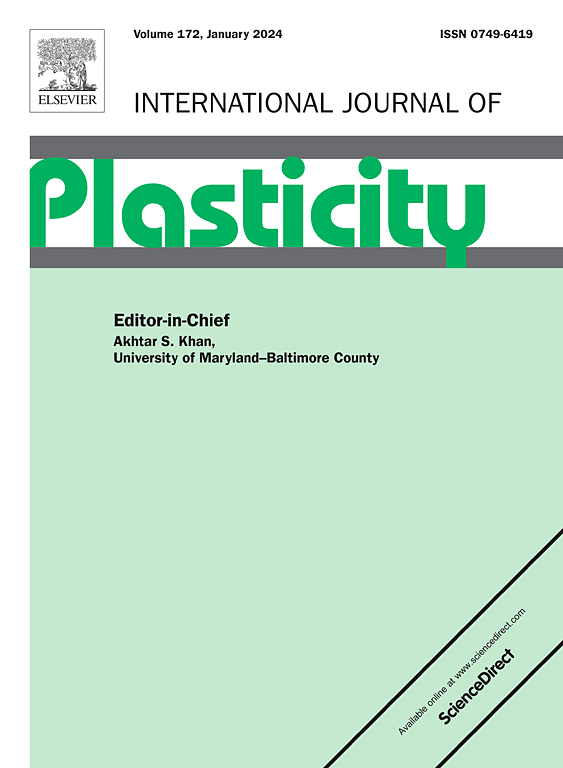通过异质结构设计和低温预拉伸的协同作用强化可蜕变中等熵合金的变形机制
IF 9.4
1区 材料科学
Q1 ENGINEERING, MECHANICAL
引用次数: 0
摘要
面心立方(FCC)中熵合金(MEAs)因其令人印象深刻的机械性能和反应而备受关注。然而,它们的实际应用却因屈服强度不高而受到限制。本研究通过异质结构设计与后续低温预拉伸相结合的协同方法,探索了提高单相中熵合金机械性能的潜力。通过两步轧制和退火,在单相 Fe55Mn20Cr15Ni10 MEA 中产生了异质薄片结构。不同程度的低温预应变(6%、12%、21% 和 36%)引入了六方紧密堆积(HCP)相、高密度位错、孪晶和堆积断层,充分利用了低温下堆积断层能量的降低。这一过程将合金的屈服强度从 353 兆帕提高到 1.2 GPa(与基线均匀粗晶粒结构相比),同时保持了 8.4% 的可接受总伸长率。利用原位同步辐射 X 射线衍射分析评估了低温预拉伸对 MEA 的微观结构和机械性能的影响。与室温应变(2.5 × 1015 m-2)相比,低温预应变(36%)实现了更高的位错密度(6.1 × 1015 m-2)。在加载条件下,对低温预应变样品的负堆积断层概率和应变诱导的 HCP→FCC 反向转变进行了观察,同时量化了加载过程中 HCP-马氏体的应力贡献和位错密度的演变。此外,还定量评估了规范微结构对提高屈服强度的贡献。本文章由计算机程序翻译,如有差异,请以英文原文为准。
Deformation mechanism of a metastable medium entropy alloy strengthened by the synergy of heterostructure design and cryo-pre-straining
Face-centered cubic (FCC) medium entropy alloys (MEAs) have received considerable attention due to their impressive mechanical properties and responses. However, their practical application is limited by their modest yield strengths. The potential enhancement of the mechanical properties of single-phase MEAs was explored in this study through a synergistic approach combining heterogeneous structure design with subsequent cryo-pre-straining. A heterogeneous lamella structure was produced in a single-phase Fe55Mn20Cr15Ni10 MEA via two-step rolling and annealing. Cryo-pre-straining at varying degrees (6, 12, 21, and 36%) introduced hexagonal close-packed (HCP) phase, high-density dislocations, twins, and stacking faults, leveraging the reduced stacking fault energy at cryogenic temperatures. This process enhanced the alloy's yield strength from 353 MPa to 1.2 GPa (compared to the baseline uniform coarse-grained structure), while maintaining an acceptable total elongation of 8.4%. The impact of cryo-pre-straining on the microstructure and mechanical properties of the MEA was assessed using in-situ synchrotron X-ray diffraction analysis. Cryo-pre-straining (36%) achieved a higher dislocation density (6.1 × 1015 m−2) compared to room-temperature straining (2.5 × 1015 m−2). The stress contribution from HCP-martensite and the evolution of dislocation density during loading were quantified, along with observations of negative stacking fault probability and strain-induced HCP→FCC reverse transformation in cryo-pre-strained samples under loading conditions. Furthermore, the contributions of regulated microstructures to the enhancement of yield strength were quantitatively assessed.
求助全文
通过发布文献求助,成功后即可免费获取论文全文。
去求助
来源期刊

International Journal of Plasticity
工程技术-材料科学:综合
CiteScore
15.30
自引率
26.50%
发文量
256
审稿时长
46 days
期刊介绍:
International Journal of Plasticity aims to present original research encompassing all facets of plastic deformation, damage, and fracture behavior in both isotropic and anisotropic solids. This includes exploring the thermodynamics of plasticity and fracture, continuum theory, and macroscopic as well as microscopic phenomena.
Topics of interest span the plastic behavior of single crystals and polycrystalline metals, ceramics, rocks, soils, composites, nanocrystalline and microelectronics materials, shape memory alloys, ferroelectric ceramics, thin films, and polymers. Additionally, the journal covers plasticity aspects of failure and fracture mechanics. Contributions involving significant experimental, numerical, or theoretical advancements that enhance the understanding of the plastic behavior of solids are particularly valued. Papers addressing the modeling of finite nonlinear elastic deformation, bearing similarities to the modeling of plastic deformation, are also welcomed.
 求助内容:
求助内容: 应助结果提醒方式:
应助结果提醒方式:


